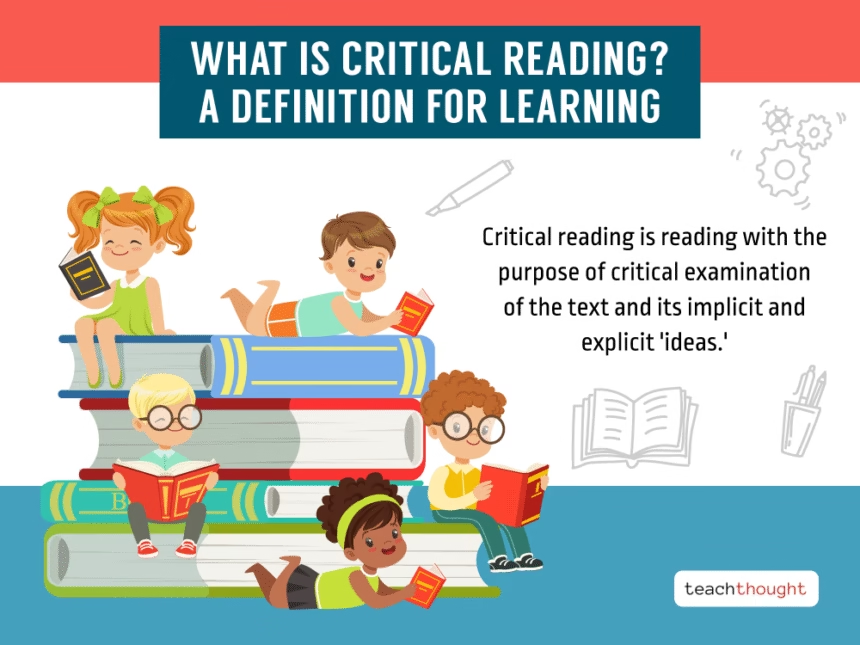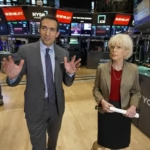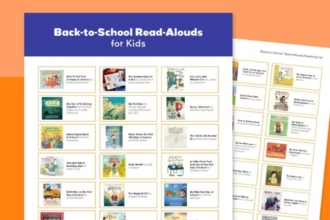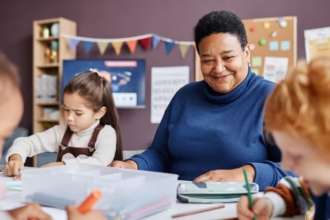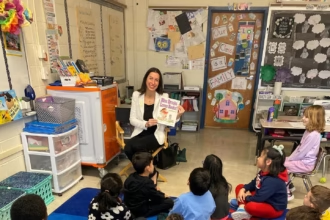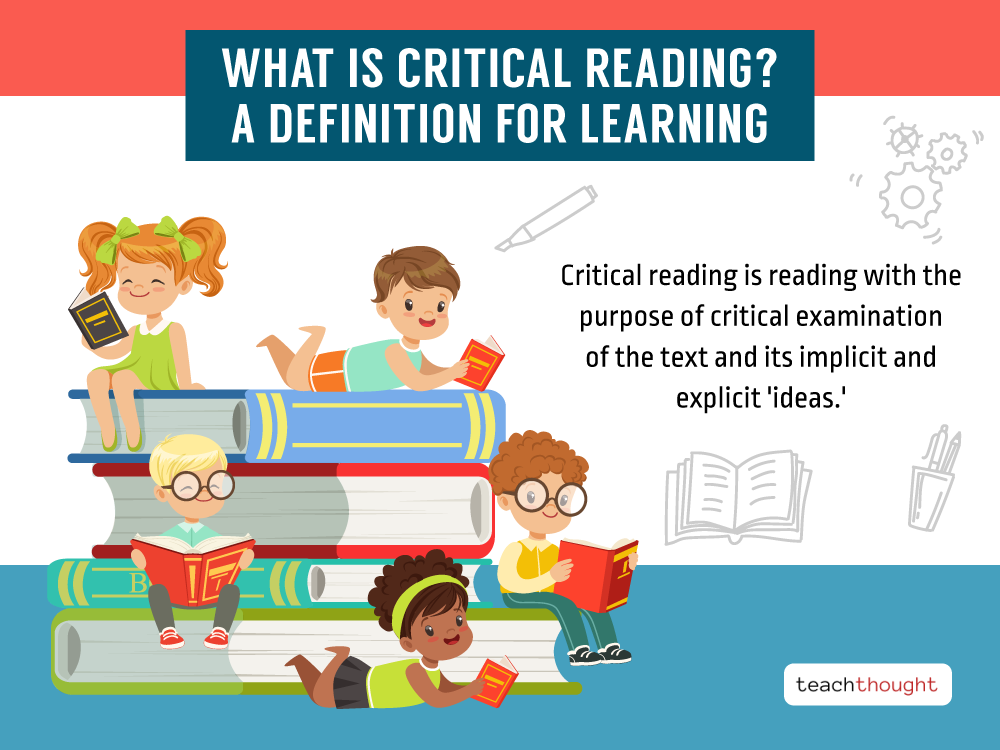

by Terry Heick
Critical reading is reading with the purpose of critical examination of the text and its ideas.
To add a bit more to that definition, we might say, “Critical reading is reading with the purpose of critical examination of the text and its implicit and explicit themes and ideas.”
What is Critical Reading? To expand on the simple definition above, critical reading is the close, careful reading of a text to understand it fully and assess its merits. It is not simply a matter of skimming a text or reading for plot points; rather, critical reading requires that you read attentively and thoughtfully, taking into account the text’s structure, purpose, and audience, among other characteristics (e.g., tone, mood, diction, etc.)
See also The Definition Of Critical Thinking
Critical reading is the process of reading texts to understand them fully. It involves asking questions about the author’s intention, the text’s structure and purpose, and the meanings of individual words and phrases. Critical readers also consider the context in which a text was written and how different audiences might interpret it.
What is a critical reading strategy? A critical reading strategy is anything the reader does that helps them evaluate a text critically.
See also Creating A Culture Of Reading In Your Classroom
What are some examples of critical reading strategies?
Critical Reading Strategies
Inferring (‘Reading between the lines’ is the act of identifying and examining implicit messages and biases.)
Claim/Counter-Claim (itemizing each and how they work/don’t work together in a specific text; concept mapping can be useful here)
Journaling (while or after reading to reflect both on the text and the process of evaluating that text)
See also 8 Of The Most Important Critical Thinking Skills
Marking The Text
Rereading
Adjusting Reading Rate
Monitoring Understanding
SPQ: Stop, Paraphrase, and Question
The Contrarian (viewing the text from a specific perspective other than your own–often the opposite of your beliefs, opinion, or perspective)
Critical Lenses (reading a text while ‘seeing’ that text through a specific concept or category–including socioeconomic, historical, gender, race, sexuality, and other ‘concepts’ or realities; this can help uncover bias, create new meaning previously inaccessible to the reader and, perhaps most importantly, help the reader understand the subjectivity of reading and how much of an impact our own biases have on our understanding of both texts we read and the world around us).
See also How To Help Your Students See Quality
Why is Critical Reading Important?
Critical reading is important because it allows you to read and analyze a text critically, breaking it down into its component parts and assessing its strengths and weaknesses. It also helps you understand the author’s purpose in writing the text and how it relates to your own life.
As the process of reading texts with a focus on understanding and evaluating the arguments and evidence presented, critical reading involves asking questions about the text, making connections to other texts, and thinking critically about the author’s argument. Critical reading is necessary for success in school and in life because it allows you to assess information critically and make informed decisions.
How To Read Critically
To read critically, you only need to read to identify and evaluate the ‘quality’ of a text.
Quality can mean different things depending on the purpose and context of a text. Note, the quality here is different than the ‘quality’ of literature or film, or other fiction. In these cases, specific hallmarks of quality certainly exist but they relate to the ability to convey a compelling fiction (e.g., tell a ‘good story’). The use of dialogue to establish characters, the use of setting to ground conflicts, and the weaving of a unifying narrative through the course of dozens of small events, each done with the purpose of helping the reader slowly uncover some truth about themselves or the world around them–these are the kinds of practices that help determine the quality of fiction.
In non-fiction form–essays, for example–quality is concerned more with the clarity and relevance of a specific claim and the author’s ability to demonstrate the importance and truth of that claim.
Wikipedia offers up a strong example of the need for critical reading: “The psychologist Cyril Burt is known for his studies on the effect of heredity on intelligence. Shortly after he died, his studies of inheritance and intelligence came into disrepute after evidence emerged indicating he had falsified research data. A 1994 paper by William H. Tucker is illuminative on both how “critical reading” was performed in the discovery of the falsified data as well as in many famous psychologists’ “non-critical reading” of Burt’s papers. Tucker shows that the recognized experts within the field of intelligence research blindly accepted Cyril Burt’s research even though it was without scientific value and probably directly faked: They wanted to believe that IQ is hereditary and considered uncritically empirical claims supporting this view. This paper thus demonstrates how critical reading (and the opposite) may be related to beliefs as well as to interests and power structures.”
Types Of Questions To Ask While Critical Reading
Critical reading is the process of analyzing a text to understand its meaning and to assess its argument. When you critically read a text, you ask yourself questions about the author’s purpose, the evidence they provide, and the logic of their argument.
Who is saying what to whom? That is, who is the author, what is their message, and who is that message for?
Is this true? By what standard?
Does the thesis pass the ‘So what?’ challenge. Put another way, are the claims being made compelling and significant? Worth understanding?
What is explicitly stated? What is implied? What is the relationship between the two?
What are the underlying assumptions of both the text and the claims within it?
Does the knowledge (facts, truths, information, data, etc.) in the text represent our current best understanding of things as they are today? If not, what has changed and why? And how does that change impact the strength and meaning of the text itself?
What here is fact and what is opinion?
What is the significance of this text?
What are the claims made by this text? Are these claims clear? Relevant? Compelling? New? That is, has this been said before?
What reasons are given to support those claims? Are these reasons aligned with the claims? That is, is the claim-evidence reasoning precise?
That is, is the claim-evidence reasoning accurate?
By formulating questions like these, you can not only guide your own comprehension of the text, you can also begin to learn how arguments (and the texts that contain them) are constructed. This can help students form rational, strong arguments of their own while also providing practice analyzing and evaluating the merit of arguments put forth by others (these can be formal academic arguments or informal ‘arguments’/claims made in real conversations on a day to day basis in their lives).
The Mindset Of Critical Reading
We bring ourselves to a reading and the ‘self’ we were is forever changed if only ever so slightly. Knowledge acquisition changes us and reading is a process of knowledge acquisition. The same text read five years ago has new meaning now because the meaning is not in the text but in your mind which has changed over that period of time. This kind of realization illustrates the necessity for critical reading (and critical thinking while reading).
See also Critical Thinking Is A Mindset
As human beings, we misunderstand too much and lack too much information and perspective. This leads to humility being one of the most important reading strategies of critical reading. By bringing that mindset to a text, we stand a better chance of evaluating the claim-reasoning strength of a text and, in doing so, stand a better chance of improving our own knowledge and critical reasoning skills.
In Why Students Should Read, I said, “When we read–really, really read–for a while, a normally very loud part of us grows quiet and limp while our mind begins unraveling new ideas. Then, pushing further, we look inward, turning our skin inside out to expose our pulsing, naked nerves to the text. We erect a sense of self to withstand the sheer momentum of the text, then rummage through the debris when it’s all over to see what’s left behind.”
Reading is interested in what was said, comprehending is interested in what was meant, and critical reading is interested in what is actually true.


